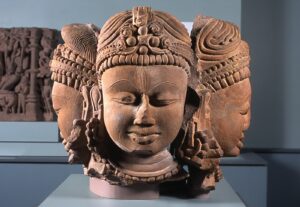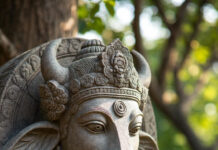Dear Je,
In almost every discussion, self-proclaimed atheists confidently say with a knowing smile, “Did you know that the word ‘Hindu’ doesn’t appear in any scriptures? Neither the Vedas, Gita, Devaram nor Thiruvasakam use that term.” I have tried repeatedly to explain this to them. If you could provide a brief explanation, it might enlighten many people who have the same question.
Shanthakumar, Mumbai
***
Dear Shanthakumar,
Such enlightenment will not come quickly. Ignorance is like a hard shell, only when it begins to crack does one start to realise their lack of knowledge and pay attention to things that matter. Atheists in our state often feign atheism simply to avoid the effort of learning anything.
The name of any religion, including ‘Hindu’ wouldn’t have existed during its inception. All names are assigned to religions over time. Religions that originated from a person or a book typically carry the name of that person or book, like Buddhism or Christianity.
Sometimes, a metaphorical name of a religion evolves over time but the sects often identify themselves with a different name. For instance, the term Sikha (Sishya), meaning disciples, eventually became the name ‘Sikhs’ and Sikhs themselves refer to their religion as Khalsa, meaning ‘path’.
Religions can also have different names depending on the place and time. The term ‘Jain’ is derived from the word ‘jina’, meaning victor. However, in Tamil Nadu, it’s known as ‘Samanam’, a modified form of the word ‘Sramanam’, which refers to fasting and hard work.
This is how religions are named. Nobody names a religion by placing it on their laps. Understanding this requires some historical knowledge that eludes many. But we must persistently keep saying this.
There are two types of religions in the world. The first type, prophetic religions, originate from a prophet or messenger. Examples include Jainism, Buddhism, Islam, and Christianity. The second type, evolutionary religions, have their origins in various modes of worship and rituals followed by ancient tribal clans. Over time, they grew into sub-religions, formed a philosophical basis, and eventually became a unified, mega-religion. Hinduism is an example of this second type of religion.
Greek and Roman religions, European Pagan religions, African religions, Japanese Shinto, Chinese Taoism, and the Bhon religion in Tibet are all examples of evolutionary religions. They only receive their names after thousands of years of formation, and these names can change as they evolve.
Hinduism’s roots can be traced back to early tribal life of an undated prehistoric era. Its earliest evidence can be found in India’s cave paintings and rock inscriptions, such as those in the Edakal and Bimpetka caves. These primitive forms of expression eventually evolved into simple rituals and sub-religions.
The religions of India began to merge right from the time we began to date history. This period of synthesis marked the birth of Hinduism. Six religions and six Darshanas (Darshanas did not follow any rules of worship. They were also referred to as religions in ancient times) were formed. This was followed by philosophical debates, leading to the compilation of the three philosophical source texts. (Prasthānatrayī/ Thathuvamuraimai).
Therefore, the fundamental structure of Hinduism comprises the Vedas, six religions (Shaivism, Vaishnavism, Saktham, Ganapathyam, Kaumaram, Sauram), six Darshanas (Sankhya, Yoga, Nyaya, Vaisheshika, Purva Mimamsa, Uttara Mimamsa), and the three philosophical source texts (Upanishads, Brahmasutra, Gita). This system has evolved over more than two thousand years through extensive spiritual and philosophical dialogues.
This synthesis is an ongoing process. Over time, the six religions were consolidated into three: Shaivism, Vaishnavism, and Saktham. Sauram merged with Vaishnavism, while Ganapathyam joined Saivism. Later, Saktham also integrated with Shaivism, leaving Shaivism and Vaishnavism as the major religions. Eventually, the stories related to this unification became the Puranas.
Shaivism and Vaishnavism grew into major religions, with many new sects merging into them. Agamas were created to unify these new sects, and numerous minor deities in Shaivism and Vaishnavism were incorporated in this manner. Leftist historians, from DD Kosambi to Suvira Jaiswal, have extensively covered this history.
In parallel, new sects began to develop from within the system, both in terms of rituals as well as philosophies. Examples include Advaita and its critics, Visishtadvaita and Dvaita. More recently, the worship of Shirdi Saibaba has developed within Hinduism and remains a strong, separate sect, branching out from the Islamic tradition. Similarly, many more traditions can potentially emerge.
In the 9th century CE, Adi Shankara brought together the six religions into a single system, forming the foundation of what we know as Hinduism today. His followers compiled more traditions under the ‘Shanmatha Samgraha’ (the unification of the six religions) brought about by their Guru. By the twelfth century, this unified system came to be known as Hinduism, a name that continues to be used today.
Within this megastructure, numerous individual traditions maintain their unique identities. There are many facets that may seem to conflict with each other, but the Hindu tradition allows for this diversity. It consists of both ritualistic traditions as well as Advaita, which rejects ritualistic worship. Both Vaishnavism, with its auspicious rituals, and Vamamarka worship, which includes all kinds of negative rituals, are part of this structure.
Hinduism, as we call it today, is a religious tradition that has evolved over time due to historical developments. It may continue to change and be given a new name in the centuries to come. It could even persist a thousand years from now under an entirely different name. Hinduism, after all, is not a registered limited company operating under a given name.
Jeyamohan
Translated from Tamil by Swetha Mayuri











